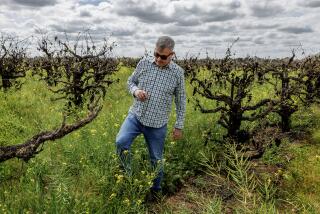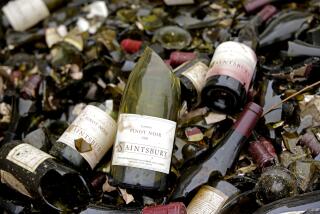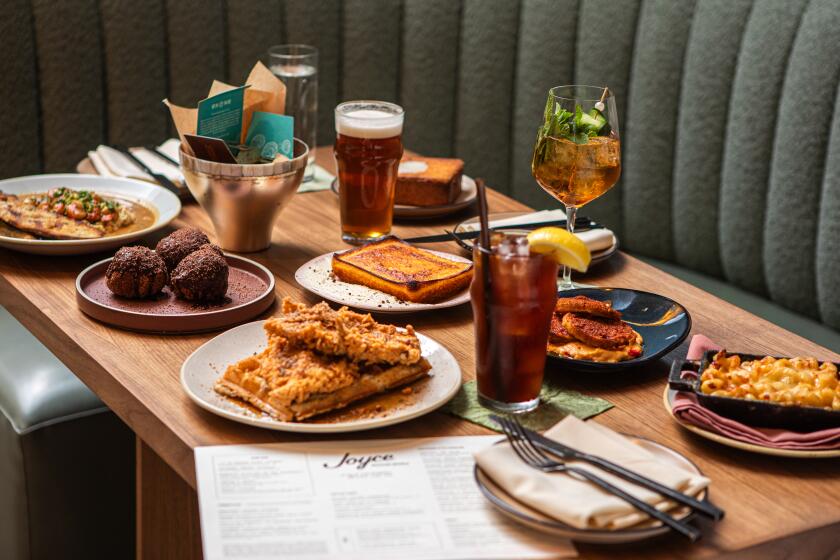Gallo Will Halt Skid Row Sales of Its Potent ‘Fortified’ Wines
E. & J. Gallo, the world’s largest wine maker, said Wednesday that it will halt sales of its high-alcohol Thunderbird and Night Train brands in Skid Row neighborhoods throughout the country.
The announcement by the Modesto-based vintner came a week after the Los Angeles County Board of Supervisors asked wineries to voluntarily suspend sales of the inexpensive wines on Los Angeles’ Skid Row in an effort to reduce alcohol-related social problems there.
The supervisors had acted after board Chairman Ed Edelman read that in June, Gallo and Canandaigua Wines of New York had voluntarily suspended sales of the so-called “fortified” wines for six months in San Francisco’s seedy Tenderloin District.
Gallo said at the time that if the test ban in San Francisco is shown to reduce alcoholism there, the San Joaquin Valley winery would pull its fortified wines off the market, permanently. However, in making Wednesday’s announcement, Gallo made no reference to any findings from the Bay Area test ban.
Gallo said Wednesday that the popularity of the fortified wines--which sell for as little as 90 cents a bottle and are laced with brandy to bring them up to about 18% alcohol--is a symptom, and not a cause, of alcoholism.
Despite the obviously heavy sales of fortified wines to alcoholics, Gallo said it was convinced that most people who drink such wines are the “many thousands of moderate and responsible consumers, many of whom are retired and on fixed incomes.”
The winery said it was “regrettable” that a few retailers “persist in selling these and other products to obvious alcoholic derelicts.
‘Thinking Is Naive’
“This practice has led to the assertion that these products cause Skid Row conditions and, therefore, that (by) stopping the sale of high-proof wine, the problem of Skid Row can be solved,” Gallo said. “We believe this thinking is naive. . . .”
While not identifying any specific areas as Skid Rows, Gallo spokesman Dan Solomon said in Modesto that the company’s local distributors should be able to determine which neighborhoods are to be covered by the ban.
“And if they can’t, we’re sure the local authorities can help,” Solomon said.
In Portland, Ore., officials said a fortified-wine ban implemented in 1986 by the Oregon Liquor Control Commission in certain neighborhoods initially tended to drive street drinkers out of the traditional Skid Row and into other parts of the city.
This led the city to expand the wine ban to a larger area, thus discouraging people from walking a few blocks for fortified wine. The city also initiated new social services for street drinkers--including involuntary incarceration, temporary housing and counseling.
Hard evidence is not yet in from the bans in San Francisco and Portland.
However, nine years ago, Norman Giesbrecht and Scott Macdonald of the respected Addiction Research Foundation in Toronto reported in an article in the British Journal of Addiction that the banning of fortified wines had made “little difference” in the overall consumption of alcohol in areas where bans have been tried in the past.
After studying a test ban of fortified wines in northwestern Ontario Province in 1975 and 1976, Giesbrecht and Macdonald reported that “substitution of other beverages is a common response” that results in late-stage alcoholics buying and drinking inexpensive distilled spirits or, more commonly, inexpensive table wines and beer when fortified wines are banned.
Basically, they found that sales of other alcoholic beverages rose as fast as fortified wine sales were shut down.
However, despite the evidence that the total volume of alcohol consumed is not greatly affected by a fortified-wine ban, Giesbrecht and Macdonald did note that during two similar bans--one elsewhere in Canada and the other in Finland--the number of drunkenness arrests, alcohol-related assaults and alcohol-related hospital admissions all declined.
Those results were noticed during beverage-worker strikes in the Maritime provinces of Canada and in Finland; the strikes dried up the supply of fortified wines.
Giesbrecht and Macdonald also reported why fortified wines are preferred by street drinkers--such wines provide the greatest volume of alcohol per dollar.
Malnic reported from Los Angeles and Stein from San Francisco. Times Wine Writer Dan Berger also contributed to this story.
More to Read
Eat your way across L.A.
Get our weekly Tasting Notes newsletter for reviews, news and more.
You may occasionally receive promotional content from the Los Angeles Times.










